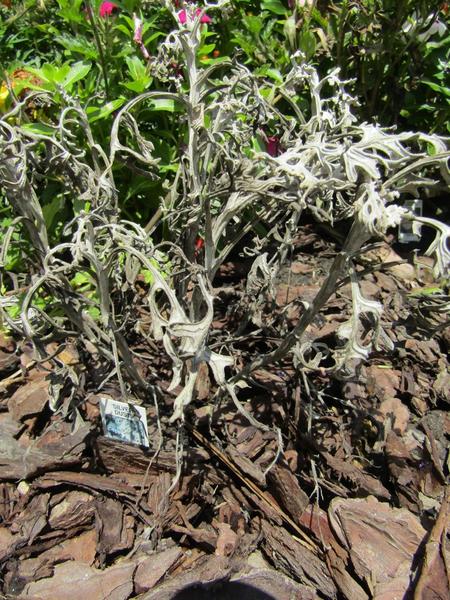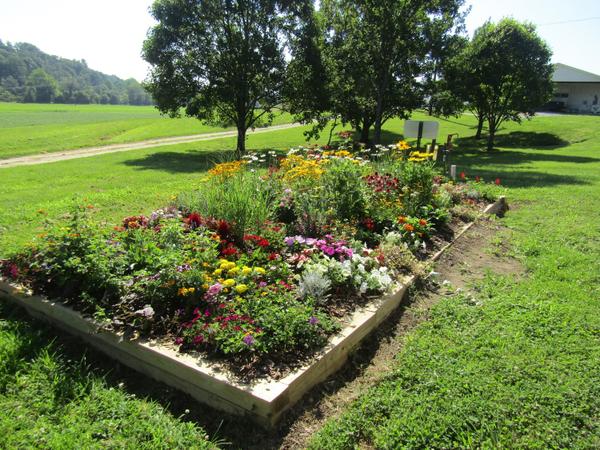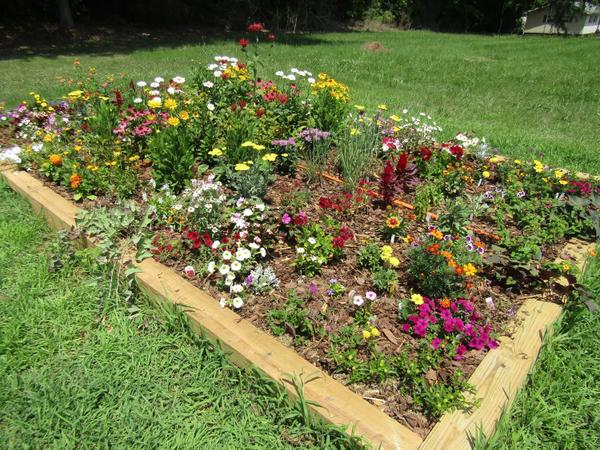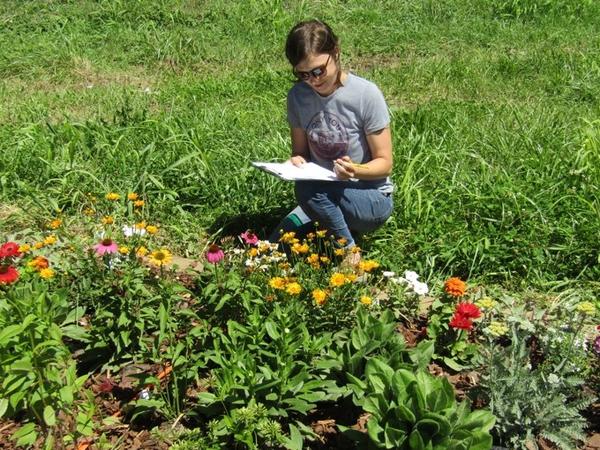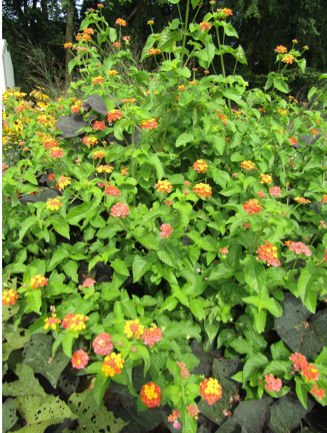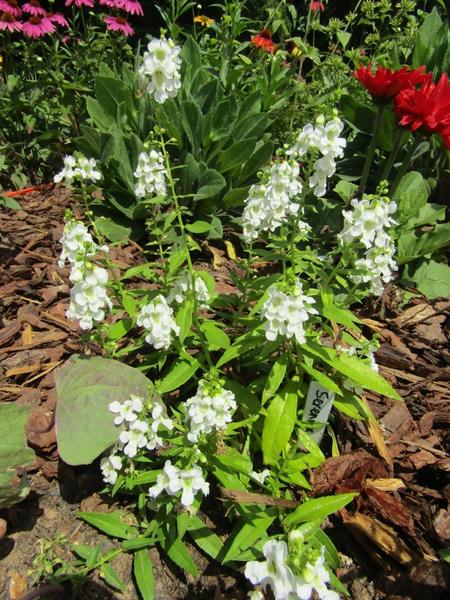Many ornamental crop species (including trees, shrubs, and bedding plants) are susceptible to disease caused by members of the genus Phytophthora, a group of fungal-like, plant-pathogenic oomycetes (also known as water molds) that can persist in soil for several years. Phytophthora species typically cause root rot or crown rot, and symptoms often include loss of older foliage, foliar blight, chlorosis, decline in vigor, branch dieback, and wilting (Figure 1, Figure 2, and Figure 3). Phytophthora root and crown rot may be managed in a landscape setting by improving soil drainage, avoiding overwatering or overfertilizing, and preventing the spread of soil, water, and plants from infested areas (see Phytophthora Blight and Root Rot on Annuals and Herbaceous Perennials). Chemical means of managing these diseases are costly and generally impractical in landscape settings.
The most sustainable and environmentally friendly management tool is the cultivation of tolerant or resistant plants. However, there has been a limited number of studies investigating species and cultivars of ornamental landscape plants that can thrive in beds with a history of Phytophthora infestation. During the summers of 2018, 2019, and 2020, we evaluated multiple species and cultivars of ornamental plants (including summer annuals and herbaceous perennials) for tolerance or resistance to Phytophthora root and crown rot in a landscape setting.
Methods
We evaluated one to five cultivars each of 21 annuals (53 cultivars total) and 27 herbaceous perennials (42 cultivars total) in three landscape beds in North Carolina for tolerance or resistance to four species of Phytophthora responsible for causing root and crown rot in the landscape setting. Plant species and cultivars were selected based on anecdotal evidence of resistance or tolerance to Phytophthora spp. as well as resistance to other common pathogens (such as powdery mildew and downy mildew), desirability in landscape beds, and consumer availability.
Three landscape beds were established in western North Carolina (Mills River, Waynesville, and Salisbury) (Figure 4, Figure 5, and Figure 6) and were infested twice each year with species of Phytophthora known to cause disease in ornamental landscape plants in North Carolina: P. nicotianae, P. tropicalis, P. dreschleri and, in 2019 and 2020, P. cryptogea. Each landscape bed was divided into four quadrants and one plant of each cultivar was planted in each of the quadrants. Plants known to be susceptible to Phytophthora spp. (gerbera daisy, annual vinca, petunia, and dusty miller) were included as positive controls to confirm that the inoculum was active. The landscape beds were irrigated daily using soaker hoses to create environmental conditions conducive for the disease.
Plants were rated every two weeks throughout each growing season (June through October) for disease incidence and severity based on visible symptoms of root rot, crown rot, or aerial blight. The disease rating scale was Excellent, Good, Fair, Poor, and Other (Table 1). As disease progressed, symptomatic plants were harvested and processed to check for the presence of Phytophthora and other common pathogens. The North Carolina State Extension Plant Disease and Insect Clinic provided disease diagnoses for some plants.
| Rating a | Type | Plant Species | Cultivar | Disease ID b |
|---|---|---|---|---|
| Excellent | Annual | Narrow-leaf zinnia (Zinnia angustifolia) | Star Orange | - |
| Star White | F | |||
| New Guinea impatiens (Impatiens hawkeri) | Sunpatiens Compact Orchid |
- | ||
| Sunpatiens Lilac | - | |||
| Sweet potato vine (Ipomoea batatas) | Bright Idea Tri-color | - | ||
| Ace of Spades | - | |||
| Angelonia (Angelonia angustifolia) | ArchAngel Pink | - | ||
| Serenita White | - | |||
| ArchAngel Blue | - | |||
| Lantana (Lantana x hybrida) | New Gold | - | ||
| Little Lucky Peach Glow | - | |||
| Little Luck Pot of Gold | - | |||
| West Indian lantana (Lantana camara) | Miss Huff | - | ||
| African marigold (Tagetes erecta) | Antigua Yellow | - | ||
| Begonia (Begonia semperflorens) | Cocktail Whiskey | Py | ||
| Floss flower (Ageratum houstonianum) | Blue Danube | - | ||
| Blue Horizon | - | |||
| Perennial | Lantana (Lantana camara) | Miss Huff | - | |
| Purple coneflower (Echinacea purpurea) | PowWow Wildberry | - | ||
| Cheyenne Spirit | - | |||
| Ornamental grass (Panicum virgatum) | Shenandoah | - | ||
| Rotstrahlbusch | - | |||
| Shasta daisy (Leucanthemum x superbum) | Becky | - | ||
| Tickseed (Coreopsis auriculata) | Nana | Py | ||
| Jethro Tull | - | |||
| Verbena (Glandularia canadensis) | Homestead Purple | A | ||
| Catnip (Nepeta x faassenii) | Kitten Around | |||
| Ornamental sedge (Carex testacea) | Prairie Fire | Py | ||
| Good | Annual | Zinnia (Zinnia elegans) | Magellan Orange | L |
| Annual vinca (Catharanthus roseus) | Cora Apricot1 | U | ||
| Cora Strawberry1 | P | |||
| New Guinea impatiens (Impatiens hawkeri) | Harmony | L | ||
| African marigold (Tagetes erecta) | Antigua Orange | F | ||
| Celosia (Celosia cristata) | Dracula | A, U | ||
| French marigold (Tagetes patula) | Janie Deep Orange | A | ||
| Janie Spry | A | |||
| Verbena hybrid (Verbena hybrid) | Superbena Royal Chambray | A | ||
| Perennial | Ornamental grass (Panicum virgatum) | Rotstrahlbusch | L, P | |
| Black-eyed Susan (Rudbeckia fulgida) | Goldsturm | L | ||
| Bugleweed (Ajuga reptans) | Burgundy Glow | - | ||
| Catlin's Giant | F | |||
| Rose mock Vervain (Verbena canadensis) | Homestead Purple | - | ||
| Ornamental grass (Miscanthus sinensis) | Little Zebra* | - | ||
| Ornamental sedge (Carex flacca) | Blue Zinger* | Py, L | ||
| Creeping phlox (Phlox subulata) | Fort Hill | |||
| White Delight | S | |||
| Salvia (Salvia nemorosa) | Violet Profusion | P, I | ||
| Verbena (Verbena peruviana) | Endurascape Red | Py, A | ||
| Fair | Annual | Geranium (Pelargonium hortorum) | Calliope Dark Red | A, U |
| Bullseye Cherry | A | |||
| Celosia (Celosia argentea) | New Look | P | ||
| Begonia (Begonia semperflorens) | Senator Deep Rose | U | ||
| Shasta daisy (Leucanthemum x superbum) | Lancaster Darling Daisy | P, U | ||
| Moss-rose (Portulaca grandiflora) | Happy Trails Series | U | ||
| Happy Hour | U | |||
| Vinca (Catharanthus roseus) | Cora Cascade Lilac | L, P | ||
| Cora Cascade Strawberry | L | |||
| Verbena hybrid (Verbena x hybrid) | Lanai Upright Rose with Eye | P | ||
| Quartz Pink | P | |||
| Quartz Red with Eye | P, Py | |||
| Perennial | Bee balm (Monarda didyma) | Petite Delight | M | |
| Jacob Cline | M | |||
| Mealy blue sage (Salvia farinacea) | Victoria Blue | P | ||
| Fernleaf yarrow (Achillea filipendulina) | Moonshine | P, U | ||
| Black-eyed Susan (Rudbeckia fulgida) | Little Goldstar | A, S | ||
| Purple coneflower (Echinacea purpurea) | Cheyenne Spirit | U | ||
| Ornamental grass (Panicum virgatum) | Shenandoah | U | ||
| Rotstrahlbusch | P, U | |||
| Ornamental sedge (Carex testacea) | Prairie Fire | Py | ||
| Russian sage (Perovskia atriplicifolia) | Denim'n Lace | P, U | ||
| Crazy Blue | P, Py | |||
| Poor | Annual | African marigold (Tagetes erecta) | Proud Yellow | A, U, F |
| Inca Yellow | A, U | |||
| Petunia (Petunia hybrida) | Violet Picotee | P | ||
| Yellow Madness | P | |||
| Calibrachoa (Petunia x calibrachoa) | SuperCal | P | ||
| Verbena hybrid (Verbena x hybrid) | Superbena Stormburst | P | ||
| Angelonia (Angelonia angustiflolia) | Night Sky | P | ||
| Alyssum (Alyssum wufenianum) | Golden Spring | P | ||
| Gazania (Gazania rigens) | New Day Tiger Mix | P | ||
| Shasta daisy (Leucanthemum x superbum) | Lucile White | U | ||
| Lobelia (Lobelia erinus) | White Riviera | U | ||
| Riviera Rose | U | |||
| Perennial | Shasta daisy (Leucanthemum x superbum) | Snow Lady | L, U | |
| Blanket flower (Gaillardia grandiflora) | Goblin | P, L, F | ||
| Mesa Bi-Color | L, P | |||
| Hybrid Yarrow (Achillea x lewisii) | King Edward | P | ||
| Hybrid Yarrow (Achillea filipendulina) | Moonshine | P, U | ||
| Catnip (Nepeta x faassenii) | Junior Walker | Py | ||
| Other | Annual | French marigold (Tagetes patula) | Disco Mix | A, U |
| Disco Yellow | A, U | |||
| Annual phlox (Phlox drummondii) | Phlox Star | A, U | ||
| Intensia Red Hot | A, U | |||
| Perennial | Garden phlox (Phlox paniculata) | Amethyst True Gal | A, U | |
| Yarrow (Achillea millefolium) | Desert Eve Red | A | ||
| Black-eyed Susan (Rudbeckia hirta)2 | Indian Summer | U, V | ||
| Prairie Sun | U, V | |||
| Lychnis (Lychnis arkwrightii) | Orange Gnome | P, A, U | ||
| Tickseed (Coreopsis x verticillata) | Starlight | U | ||
| Sunfire | U | |||
| Bee balm (Monarda didyma) | Pardon My Purple | I, M | ||
| Balmy | I, M, L, N | |||
| Pardon My Cerise | I, M | |||
| Black-eyed Susan (Rudbeckia fulgida) | Little Goldstar | A, S |
a Disease Rating Scale: Excellent = no disease symptoms, excellent floral quality, survived entire growing season.
Good = minor disease symptoms (< 25% leaf area affected), good floral quality, most survived entire growing season.
Fair = moderate disease symptoms (~ 50% leaf area affected), less than half (< 6) the plants died before end of growing season.
Poor = severe disease symptoms (> 50% leaf area affected), more than half (> 6) the plants died before end of growing season.
Other = more than half (> 6) the plants had other diseases or had abiotic or unknown issues that prevented a fair trial of the cultivar’s resistance to or tolerance of Phytophthora.
b Disease ID Letter Code: A: Abiotic disorder, F: Fusarium wilt, L: Leaf spot, M: Powdery mildew, S: Southern blight, Py: Pythium root rot, N: Nematodes, P: Phytophthora root rot or stem rot, or aerial blight, U: Unknown, V: Verticillium wilt. 1 Other research has shown the Cora® series to be susceptible to some strains of P. nicotianae.
2 Verticillium wilt is not generally a concern in warmer climates (> 81°F).
Results and Conclusion
We identified 18 cultivars among 10 annual plant species, as well as 13 cultivars among 10 herbaceous perennial plant species, whose performance was rated as Excellent (Figure 10, Figure 11, and Figure 12). Phytophthora spp. were not isolated from the roots of any of these plants, suggesting that they are not hosts of this pathogen. Nine cultivars among 7 annual plant species and 11 cultivars among 9 herbaceous perennial plant species were rated as Good, although some of these cultivars were diagnosed with diseases such as Fusarium wilt, leaf spot, and abiotic disorder. Phytophthora spp. were isolated from the roots of three cultivars rated as Good. In many cases, the cause of disease for plants rated as Fair was difficult to identify, although Phytophthora spp. were isolated from the roots of some of these plants. Phytophthora spp. were frequently isolated from the roots and crowns of plants rated as Poor (Table 1). Based on the results of this study, we recommend that the 27 cultivars of annuals and 24 cultivars of herbaceous perennial landscape plants whose performance was rated as Excellent or Good in this study be grown in landscape beds with a history of Phytophthora infestation.
Disclaimer
Some of the plants listed in this publication may be susceptible to other plant pathogens. Good cultural management practices are recommended to keep pests and pathogens out of the landscape.
Resources
Phytophthora Blight and Root Rot on Annuals and Herbaceous Perennials Disease Factsheet
NC State Extension Plant Disease and Insect Clinic
Southeastern US Pest Control Guide for Nursery Crops and Landscape Plantings
North Carolina Agricultural Chemicals Manual
Inga Meadows Plant Pathology Lab for Vegetables and Herbaceous Ornamentals
Acknowledgments
The authors would like to thank Area Specialized Extension Agents Amanda Taylor and Stacey Jones and the participants at the 17th Ornamentals Workshop in Kanuga (Hendersonville, North Carolina) for their input into this publication. We also want to thank the nurseries in North Carolina who generously provided plants that made this study possible: Hawks Ridge Farms, Metrolina Greenhouses, Hoffman Nursery, King’s Nursery, Plantworks Nursery, Cold Mountain Nursery, Rountree Plantation, Homewood Nursery and Garden Center, and Fairview Garden Center. Thanks also to Michael Munster, Fulya Baysal-Gurel, and Margery Daughtrey for providing valuable feedback on this publication.
This research was supported by two grants from the Horticultural Research Institute (HRI). Its contents are solely the responsibility of the authors and do not necessarily represent the views of HRI.
Publication date: March 18, 2021
AG-747
N.C. Cooperative Extension prohibits discrimination and harassment regardless of age, color, disability, family and marital status, gender identity, national origin, political beliefs, race, religion, sex (including pregnancy), sexual orientation and veteran status.



